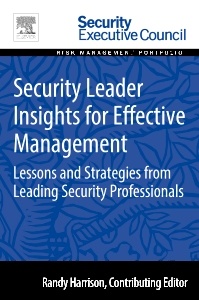Description
Security Leader Insights for Effective Management
Lessons and Strategies from Leading Security Professionals
Coordinator: Harrison Randy
Language: English
Subject for Security Leader Insights for Effective Management:
108 p. · 15x22.8 cm · Paperback
Description
/li>Contents
/li>Biography
/li>Comment
/li>
How do you, as a busy security executive or manager, stay current with evolving issues, familiarize yourself with the successful practices of your peers, and transfer this information to build a knowledgeable, skilled workforce the times now demand? With Security Leader Insights for Effective Management, a collection of timeless leadership best practices featuring insights from some of the nation?s most successful security practitioners, you can.
This book can be used as a quick and effective resource to bring your security staff up to speed on topics such as the characteristics of effective security leaders and programs, leading through difficult times, budget issues, and aligning security with business goals. Instead of re-inventing the wheel when faced with a new challenge, these proven practices and principles will allow you to execute with confidence knowing that your peers have done so with success.
Security Leader Insights for Effective Management is a part of Elsevier?s Security Executive Council Risk Management Portfolio, a collection of real world solutions and "how-to" guidelines that equip executives, practitioners, and educators with proven information for successful security and risk management programs.
Introduction Part 1: What Do Effective Security Leaders and Programs Look Like? 1. What Every Security Leader Should Know Seven experienced security practitioners share the essential information every security leader should know about the profession. 2. Strategic Planning: Your Roadmap to Success Ensure your security organization has aclear direction and mission with these tips for strategic planning. 3. You Get the Behavior You Reward Learn how to encourage enterprise, horizontally-integrated behavior by adapting a culture of partnership and information sharing. 4. Four Strategies to Fill the Resource Gap An experienced security executive shares four strategies to make up for a lack of security resources. 5. Setting a New Standard of Collaboration A case study of collaboration between two security organizations that can serve as an example for a new standard of collaborative partnerships. 6. Local Vigilance Drives Global Defense at Raytheon Using the example of Raytheon Missile Systems, an experienced security professional describes how to promote awareness to build a sense of unity around a common purpose and common cause. 7. Developing a Successful Executive Partnership The CEO and security executive at Baker Hughes Inc. define the elements of a successful collaboration between the business and security executives. Part 2: Leading through Difficult Times 8. Coping with Changes to Company Leadership Strategies for dealing with the transition to a new management agenda following a change in organizational leadership 9. Strategies for Career Preservation Learn how to best position yourself for career preservation with the advice of four experienced security professionals. 10. Dealing with Downsizing Better understand your options for maintaining your current level of protection even when being required to downsize your staff. 11. Extreme Security Program Makeover Experienced security practitioners explain how to build or rebuild a security program after corporate restructuring, layoffs, or budget cuts. Part 3: Budget Issues 12. Managing and Defending a Security Budget Tips for laying a foundation beneath any security budgeting process to help enhance efficiency and effectiveness, and even help position the security leader for advancement. 13. Leading and Managing in a Global Economy One experienced security professional shows how to think globally and predict business risk factors in the global market. 14. How to Move Security Projects Forward while Cutting Costs Four experienced security professionals share strategies for advancing security projects and programs even when the budget is tight. Part 4: Aligning Security with the Business 15. Seven Ways to Maximize Value to the Corporation Identify new methods for contributing to the organization’s success with these seven strategies from an experienced security practitioner. 16. Security in a J.A.R. Security doesn’t need to be perfect to keep our organizations safe—what we need is just about right (J.A.R) security. 17. How Will Business and Risk Drivers Impact Your Mitigation Strategy? Five experienced security professionals explore how changing business trends should impact security and security’s strategies for mitigating risk.
- Each chapter can be read in five minutes or less, and is written by or contains insights from experienced security leaders.
- Can be used to find illustrations and examples you can use to deal with a relevant issue.
- Brings together the diverse experiences of proven security leaders in one easy-to-read resource.




